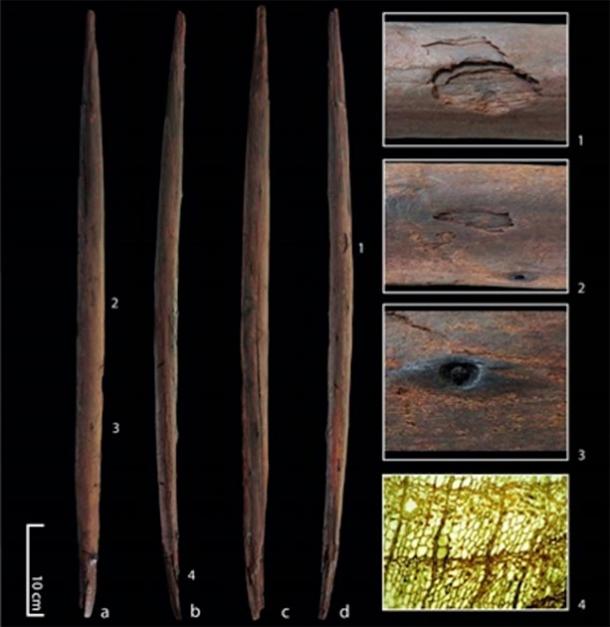
300,000-Year-Old ‘Killing Stick’ Sheds Light on Evolution of Hunting
In Germany, a team of experts have made a very important discovery. They have established that an ancient wooden artifact is a throwing stick (or ‘killing stick’). This is allowing them to understand how an early species of human were able to hunt in Europe some 300,000 years ago and shows that they were more sophisticated and advanced than widely assumed.
The throwing stick was made at Schöningen in northern Germany, where mining has revealed a number of important archaeological sites that date to the Middle Pleistocene. A great deal of significant finds have been made here including wooden tools and weapons, which typically don’t survive from this era. This is because they “have been continuously waterlogged and anoxic, fostering outstanding preservation,” reports Nature.

The ice age hunters may have used the throwing stick / ‘killing stick’ to hunt water birds. (Eberhard Karls Universität Tübingen)
Ancient Hunting Weapons
The sites are connected to an ancient lakeshore, which was once used by ancient humans to hunt and butcher their prey, based on the number of animal remains found here, which included those of extinct horses. The site was occupied by early humans for a lengthy period of time. Some of the weapons and implements that have been found here were made by the extinct archaic human Homo heidelbergensis. This species is believed to have been the ancestor of Neanderthals and modern humans.
Several examples of hunting weapons have been found at the site including throwing spears. Among the items that were recovered at Schöningen was a wooden implement, which has two points at each end and is about 2 feet (65 cm) long. It too like the other wooden finds were made from spruce. According to the report in Nature, initially several theories were proposed for the item’s function, “including a throwing stick, a digging stick, a bark peeler and a child’s spear.”

The throwing stick / ‘killing stick’ at the excavation site. (Eberhard Karls Universität Tübingen)
Killing Stick Used to Hunt Game
However, the team concluded that the artifact was a throwing stick based on its similarity to other examples of this hunting weapon from ethnographic studies of Aboriginals in Australia and tribes in Africa. To understand the function of the stick, Veerle Rots, from the University of Liège in Belgium, conducted a wear analysis of the stick. This identified the various impact marks and damage on the artifact and compared them to the patterns on other throwing projectiles used to kill game. This was used by the team in their research to prove that the wooden object was almost certainly a throwing stick used in hunts.
Throwing sticks are wooden implements also known as “killing sticks” thrown by the hunter and they would spin around and were reminiscent of boomerangs. They flew straight through the air and this made them more accurate. They could travel at speeds of up to 100 feet (30m) a second. According to Dr. Jordi Serangeli, one of the co-authors in the study, “they are effective weapons at diverse distances and can be used to kill or wound birds or rabbits or to drive the larger game, such as the horses that were killed and butchered in large numbers in the Schöningen lakeshore,” reports Heritage Daily.

The ‘killing stick’ from the Schöningen site in Germany with four views of the artifact and details showing impact marks. (Eberhard Karls Universität Tübingen)
- Are These Tools Left by Paleolithic Travelers on the Beringia Land Bridge?
- DNA from Ancient Denisovan Tooth Sheds Light on Mysterious Human Relative
- DNA Study Suggests Early Neanderthals Had Europe As Their Homebase
Europe’s First Throwing Stick?
This research demonstrated that the “maker of the throwing stick used stone tools to cut the branches flush and then to smooth the surface of the artifact,” reports Heritage Daily. The discovery that the mysterious object is a throwing or killing stick is something of a first and adds to our knowledge of the diffusion of this hunting technology. According to Nature, “outside Schöningen, Paleolithic examples of throwing sticks are unknown.” Although one, from a Polish site, carved out of a mammoth tusk may have been found, but this is not definite.
Heritage Daily quotes one of the study’s co-authors, Nicholas Conard, as saying that “the chances of finding Paleolithic artifacts made of wood are normally zero.” This is what makes the area so important. The study of the throwing stick helps us to understand the development of hunting. Early humans used multiple weapons and they were similar to much later human societies, such as the Aboriginals and some African tribes. This allowed them to sustain themselves in what could have been a very harsh and unforgiving environment.
The killing stick is allowing us to understand much more about the Middle Pleistocene era. The team wrote, “the throwing stick provides evidence of the advanced hunting skills and technological sophistication of archaic hominins in Northern Europe.” This is evidence that they were more technologically advanced and sophisticated than popularly believed.
Top image: Main: View over the excavations in Schöningen in Germany. Inset: The ‘killing stick’ that was unearthed at the excavation site. Source: Eberhard Karls Universität Tübingen
By Ed Whelan















